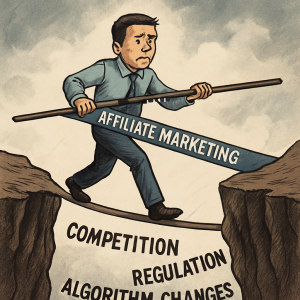Affiliate marketing continues to be a lucrative field, but as with any evolving industry, it presents a unique set of challenges and pitfalls that marketers must navigate, especially as we move further into 2025. The landscape is constantly shifting, influenced by technological advancements, changing consumer behaviors, and increased competition. Understanding these hurdles is crucial for sustained success.
1. Increased Competition and Market Saturation
The affiliate marketing space has become increasingly saturated. The low barrier to entry has attracted a vast number of individuals and businesses, leading to fierce competition for audience attention and conversions. To stand out, affiliates must offer unique value propositions, niche down effectively, and create highly targeted, high-quality content. Generic approaches are no longer sufficient.
2. Ad Blockers and Diminishing Reach
Ad blockers are more prevalent than ever, significantly reducing the reach and effectiveness of traditional advertising methods like display ads. This forces affiliate marketers to pivot towards more organic and native advertising strategies, such as content marketing, SEO, and engaging directly through social media channels where ad blockers have less impact. Relying solely on paid advertising without diversifying traffic sources is a major pitfall.
3. Evolving Regulatory Landscape
Data privacy regulations, such as GDPR and CCPA, are continually evolving, impacting how affiliate marketers collect, use, and track consumer data. Non-compliance can lead to severe penalties. Affiliates must ensure their practices are transparent, obtain proper consent, and adhere to all relevant data protection laws. This requires ongoing vigilance and adaptation of tracking and data collection methods.
4. Algorithm Updates and Traffic Volatility
Search engine algorithms (e.g., Google) and social media platform algorithms are subject to frequent updates. These changes can drastically alter content ranking and visibility, leading to sudden drops in organic traffic. Over-reliance on a single traffic source, particularly organic search or a specific social media platform, makes affiliates vulnerable to these unpredictable shifts. Diversifying traffic sources and consistently producing high-quality, adaptable content are essential.
5. Erosion of Consumer Trust
With the proliferation of misinformation and low-quality products being promoted, consumer skepticism towards affiliate marketing is on the rise. Building and maintaining credibility is paramount. Affiliates must prioritize transparency, provide genuine product reviews, and establish themselves as trusted authorities in their niche. Promoting products or services solely for commission, without genuine belief in their value, will ultimately erode trust and lead to long-term failure.

6. Attribution Complexities
The modern consumer journey often involves multiple devices and channels, making accurate sales attribution increasingly complex. It can be challenging to pinpoint the exact affiliate touchpoint responsible for a conversion, leading to potential misattribution and incorrect commission payouts. Advanced analytics and robust tracking systems are necessary to ensure fair compensation and accurate assessment of marketing efforts.
7. Rising Advertising Costs
8. Content Saturation and the Need for Innovation
The internet is awash with content, making it difficult for affiliate marketers to capture and retain audience attention. Repetitive or low-quality content is easily overlooked. Affiliates must continuously innovate their content formats, provide unique insights, and offer niche-specific expertise to stand out. Generic content strategies will fail to resonate with increasingly discerning consumers.
9. Navigating Diverse Payment Models
Affiliate marketing involves various payment models, including Cost Per Click (CPC), Cost Per Acquisition (CPA), and Cost Per Lead (CPL). Each model has its own opportunities and risks. Understanding the nuances of each, and strategically structuring campaigns to maximize revenue based on the product, audience, and chosen model, is vital for success.
10. Rapid Technological Advancements
The pace of technological change is accelerating, with new tools, platforms, and best practices emerging constantly. Affiliates must commit to continuous learning and adaptation to leverage these advancements effectively. Failing to adopt new technologies, such as AI-driven analytics or personalized marketing platforms, can lead to a significant competitive disadvantage.
Conclusion



